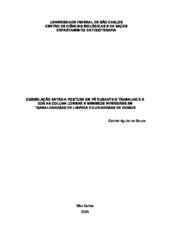| dc.contributor.author | Souza, Gabriel Aguiar | |
| dc.date.accessioned | 2021-07-13T21:18:21Z | |
| dc.date.available | 2021-07-13T21:18:21Z | |
| dc.date.issued | 2020-12-15 | |
| dc.identifier.citation | SOUZA, Gabriel Aguiar. Correlação entre a postura em pé durante o trabalho e a dor na coluna lombar e membros inferiores em trabalhadoras de limpeza e cuidadoras de idosos. 2020. Trabalho de Conclusão de Curso (Graduação em Fisioterapia) – Universidade Federal de São Carlos, São Carlos, 2020. Disponível em: https://repositorio.ufscar.br/handle/ufscar/14594. | * |
| dc.identifier.uri | https://repositorio.ufscar.br/handle/ufscar/14594 | |
| dc.description.abstract | Standing posture during work has been associated with musculoskeletal symptoms. However, few studies assess standing time using objective measures. Thus, the aim of this study was to verify whether standing time at work is associated with low back and lower limbs pain in the last seven days and 12 months in elderly caregivers and cleaners. This is a cross-sectional study. Standing time at work was quantified using inclinometers attached to the workers’ thigh and spine. Musculoskeletal symptoms were assessed using the Nordic Musculoskeletal Questionnaire. Data were analyzed using the point biserial correlation (rpb) between standing time at work and the presence of musculoskeletal symptoms. The analyzes were performed using the SPSS software and the level of significance adopted was 5%. Workers spend most of their time standing still (41.3%) or walking (39.3%). There was a positive correlation between the presence of symptoms in the lower back and standing time (rpb=0.52; p<0.05). There was a negative correlation between walking time and symptoms at the hip (12 months) (rpb=-0.53; p<0.05) and running time and symptoms at the hip (seven days) (rpb=-0.43; p<0.05) and lower back (rpb=-0.43; p<0.05). Longer standing time was correlated with the presence of symptoms in the lower back. Meanwhile, more time walking and running correlated with the absence of musculoskeletal symptoms in the lumbar spine and hips. | por |
| dc.description.sponsorship | Fundação de Amparo à Pesquisa do Estado de São Paulo (FAPESP) | por |
| dc.language.iso | por | por |
| dc.publisher | Universidade Federal de São Carlos | por |
| dc.rights | Attribution-NonCommercial-NoDerivs 3.0 Brazil | * |
| dc.rights.uri | http://creativecommons.org/licenses/by-nc-nd/3.0/br/ | * |
| dc.subject | Exposição ocupacional | por |
| dc.subject | Ergonomia | por |
| dc.subject | Transtornos traumáticos cumulativos | por |
| dc.subject | Postura | por |
| dc.subject | Fisioterapia | por |
| dc.subject | Occupational exposure | por |
| dc.subject | Ergonomics | por |
| dc.subject | Cumulative trauma disorders | por |
| dc.subject | Posture | por |
| dc.subject | Physical Therapy Specialty | por |
| dc.title | Correlação entre a postura em pé durante o trabalho e a dor na coluna lombar e membros inferiores em trabalhadoras de limpeza e cuidadoras de idosos | por |
| dc.title.alternative | Correlation between standing posture during work and lumbar spine and lower limbs pain among cleaners and eldercare workers | por |
| dc.type | TCC | por |
| dc.contributor.advisor1 | Sato, Tatiana de Oliveira | |
| dc.contributor.advisor1Lattes | http://lattes.cnpq.br/3456494998257229 | por |
| dc.contributor.advisor-co1 | Cardoso, Viviane de Freitas | |
| dc.contributor.advisor-co1Lattes | http://lattes.cnpq.br/0093888387165501 | por |
| dc.description.resumo | A postura em pé durante o trabalho tem sido correlacionada a sintomas musculoesqueléticos. Entretanto, poucos estudos avaliam o tempo em pé utilizando medidas objetivas. Assim, o objetivo deste estudo foi verificar se o tempo em pé no trabalho está correlacionado com dor na coluna lombar e membros inferiores nos últimos sete dias e 12 meses em cuidadoras de idosos e trabalhadoras de limpeza. Trata-se de um estudo transversal. O tempo em pé no trabalho foi quantificado por meio de inclinômetros fixados na coxa e coluna vertebral. Os sintomas musculoesqueléticos foram avaliados por meio do Questionário Nórdico de Sintomas Osteomusculares. Os dados foram analisados por meio da correlação ponto bisserial (rpb) entre o tempo em pé no trabalho e a presença de sintomas musculoesqueléticos. As análises foram realizadas por meio do software SPSS e o nível de significância adotado foi de 5%. As trabalhadoras passam a maior parte do tempo em pé paradas (41,3%) ou andando (39,3%). Houve correlação positiva entre a presença de sintoma na lombar e o tempo em pé (rpb=0,52; p<0,05). Houve correlação negativa entre o tempo andando e sintomas no quadril (12 meses) (rpb=-0,53; p<0,05) e o tempo correndo e sintomas no quadril (sete dias) (rpb=-0,43; p<0,05) e coluna lombar (rpb=-0,43; p<0,05). O maior tempo em pé foi correlacionado com a presença de sintomas na lombar. Enquanto que o maior tempo andando e correndo se correlacionaram com a ausência de sintomas na coluna lombar e quadril. | por |
| dc.publisher.initials | UFSCar | por |
| dc.subject.cnpq | CIENCIAS DA SAUDE::FISIOTERAPIA E TERAPIA OCUPACIONAL | por |
| dc.description.sponsorshipId | 2018/18144-2 | por |
| dc.publisher.address | Câmpus São Carlos | por |
| dc.contributor.authorlattes | http://lattes.cnpq.br/2378863890472348 | por |
| dc.publisher.course | Fisioterapia - Fisio | por |

